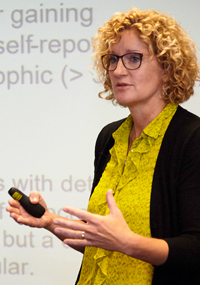
State driver licensing programs that require teenagers to gain experience before earning full driving privileges have helped promote safety on the roadways. However, a working paper cowritten by an economist at the Federal Reserve Bank of Atlanta finds such programs have also played a role in reducing youth workforce participation.
Melinda Pitts, director of the Atlanta Fed's Center for Human Capital Studies, examined the potential relationship between a decline in teen labor participation and the introduction of graduated driver license programs (GDLs), which allow younger people to become licensed in stages but restrict their driving during the process.

The Atlanta Fed’s Melinda Pitts.
Photo by David Fine
Pitts worked with researchers Laura Argys of the University of Colorado at Denver and Tom Mroz of Georgia State University. The researchers used public data from the Insurance Institute for Highway Safety, state teen licensing websites, and the Current Population Survey, which polls 60,000 U.S. households each month, to analyze labor market activity and state GDL programs implemented from 1995 to 2015.
All states have adopted more restrictive driving laws for teenagers, most of them since the 1990s. Typically, the graduated license programs have a three-stage licensing system that includes limits on nighttime driving by teenagers and restrictions on the number of passengers allowed in a vehicle with a younger driver. The researchers also noted whether states allow exemptions to the GDL restrictions for employed teenagers.
Policies driven by good intentions
Their study, detailed in a July research paper, concluded that almost half of the decline in labor force participation since 1995 in the states studied were attributed to the presence of GDL programs. "We do find a meaningful impact," Pitts said during a recent episode of the Economy Matters podcast.
Specifically, the research paper states that the overall workforce participation rate fell to below 30 percent in 2012 from above 45 percent around 1995. The authors associated about half of that decline, or 8 percentage points, with GDL limits (see the chart).
While GDLs have cut the number of teen accidents and fatalities, the researchers point out, they have also cut teen work experience and income. To address the decline in work experience, "policymakers and schools may need to enhance work readiness and facilitate work experience to offset this decline," the paper states.
The lower labor force participation finding is significant because teenagers benefit from participating in the job market: working a moderate number of hours during high school can lead to higher grades and increased wages in early adulthood, according to the paper.
"Early work experiences are impactful in the educational and employment outcomes for youth as they get older," said Stuart Andreason, director at the Atlanta Fed's Center for Workforce and Economic Opportunity.
He noted that although some schools have brought work experiences into the classroom through apprenticeships, access to transportation can pose a hurdle to teenagers working at off-site locations, even apart from GDL programs.
"If kids who have access to a car and can drive are losing job opportunities because of graduated driver licenses, let's not forget about the kids whose families don't have access to a car and what that means about their potential economic outcomes," Andreason said.
Increasing the teen-worker cohort
Lori Heemann, executive director of Great Promise Partnership, a nonprofit group that places at-risk high-schoolers in jobs, said many employers welcome the opportunity to hire teenagers when they are still in school. The partnership targets students from low-income families who are at least 16, and they divide their day between attending classes and working at their jobs. Students in the program can keep their jobs only if they go to class and stay in school.
"The majority of our employers see this as a workforce development opportunity. Their biggest cost is employee turnover and training," Heemann said. She added that participating employers feel they can have more influence on younger workers and build work relationships that can last. Upon graduation, many students in the partnerships have job offers in hand, she said.
"It's a win for everyone, from society and the community to the employer and the student," she said.




